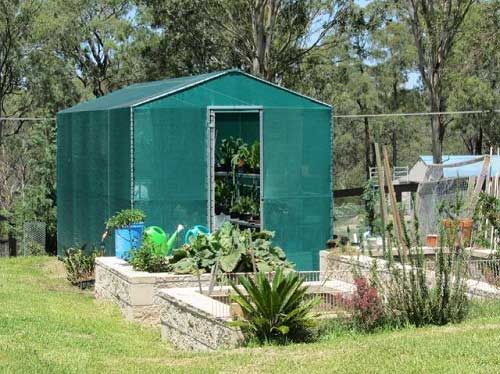 Sunlight is necessary for plant growth. Vegetables, flowers and herbs need sunlight in order to produce their food. However, too much sunlight can dry out your plants.
Sunlight is necessary for plant growth. Vegetables, flowers and herbs need sunlight in order to produce their food. However, too much sunlight can dry out your plants.
In places with hot climates, nursery plants and shade-loving flowers need to be grown in shade houses to reduce light and heat intensity. Shade houses also help plants to have better quality and higher yield.
To make the best growing envrionment for your plants, below are 4 things you should know about Shade House and Shade Clothes.
What is the purpose of shade house?
Too much heat can stop the process of photosynthesis of plants and slow down its growth. In this way, shade house is perfect for growing vegetables, herbs, flowering plants, propagating seeds and indoor plants, etc. Warm temperature builds up in the shade house that allows plants to keep growing even in winter/cold months.
The shade house is also used for orchids, ferns, palms or any shade loving plants. It improves light diffusion, ventilation and decreases summer heat for your plants.
Shade houses provide the best growing condition for your plants thus help minimise your irrigating and fertilizing cost. Shade houses consist of a shade cloth which protects plants from the harsh effects of the sun, extreme wind and insects.
What is a shade cloth?
Shade fabric is a knit or woven fabric designed to reduce the amount of solar heat that reaches plants. With the invention of shade cloth, gardeners can now control the heat and light that their plants to be exposed to.
Shade nets have different density percentage ranging from 5% to 95%. It only depends on the amount of solar heat to be blocked and what kind of plants need protection.
What shade cloth density percentage suits your plants?
Shade cloth materials have different levels of sun penetration. If the density percentage is only 30%, it means that 30% of light is blocked and the remaining 70% can pass through it.
The percentage of sun blockage required depends on the plants that you want to grow in your garden shade house. Considering the level of heat protection in your shade house is essential in order to have healthier plants. Below are examples of shade cloth density percentages.
- 30% to 50%
Ideal for vegetables, fruit trees and other nurseries plants. Shade cloth will also offer your vegetables and fruit trees protection from birds.
- 50% to 75%
Common density percentage of shade houses and is suitiable for most shade loving plants. This percentage is usually used for instances where the shade house is receiving more intense sunlight.
- 90%
Ideal as a ground cover to prevent weed growth. It is also great for privacy screening and maximum shade protection.
Shade cloth can be considered as an investment because it reduces energy and water costs especially during extreme weather. To make it more effective, there are various plants that are appropriate to grow in a shade house.
What plants suit the shade houses growing environment?
Sunlight is essential to your plant’s growth, but excessive sunlight will damage the plants. Thus, the amount of sunlight allowed to penetrate to your plants in a shade house should be under controlled.
Before choosing the right shade house, you should also consider your location and the type of plants seeking for shade.
Cool season
Many cool season crops tend to wither during hot summer. Crops like broccoli, lettuce, carrots and peas are suited for shade cloth with 50% density. Utilising a shade house can prevent these vegetables from getting bitter or woody.
Here is a list of some cool season plants that can also be grown in shade houses:
- Beets
- Brussels sprouts
- Cabbage
- Cauliflower
- Collards
- Kale
- Kohlrabi
- Mustard
- Onions
- Potatoes
- Radishes
- Rutabagas
- Spinach
- Turnips
Warm season
Vegetables such as tomatoes, peppers, squash and cucumbers are suited for shade cloth with 20% to 30% density. These plants often need extra lighting and hand-pollination. A well chosen shade house ensure you can produce your favourite summer vegetables.
Here is a list of warm season crops that can be grown in shade houses:
- Beans
- Cantaloupes
- Corn
- Eggplant
- Watermelons
- Okra
- Southern peas
- Sweet potatoes
Tropical
Tropical plants have higher demand to use Shade House for creating a best growing environment. A per cent shade between 50 % and 70% is recommended because it is generally used for shade-loving plants.
Here is a list of tropical plants that that can be cultivated in shade houses:
- Orchids
- Stream Lily (Helmhotzia glabberima)
- Native Violet
- Midgen Berry
- Lemon Myrtle
Success on choosing the right shade house and shade clothes depend on specific type of plants you are growing and the care and attention you give to your plants. As they said, "there is not always no one size fits all" solution.
Conclusion
Plants require sunlight to grow and flourish. However, each plant has unique light and heat preferences. Utilising the right shade houses and shade cloth can help your plants to be healthy and have better production. Having too less or too much sunlight can damage your plants.
If you would like to learn more on Shade houses and Shade clothes, go to cmac.com.au/blog, knowing on how to project your plants, how to increase their growth rate and how increase the plants' appearance are very esstial lessions to learn.








